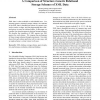Free Online Productivity Tools
i2Speak
i2Symbol
i2OCR
iTex2Img
iWeb2Print
iWeb2Shot
i2Type
iPdf2Split
iPdf2Merge
i2Bopomofo
i2Arabic
i2Style
i2Image
i2PDF
iLatex2Rtf
Sci2ools
APPINF
2003
2003
A Comparison of Structure-generic Relational Storage Schemes of XML Data
XML data is often modeled as node-labeled trees. In a structure-generic relational storage scheme, the structure of the XML data is shredded into pieces of a generic type, such as nodes or edges, and data representing these structural pieces is stored in relational tables. In this paper, we consider four structure-generic relational storage schemes. We describe the translation of XML queries into SQL queries for each scheme. We compare the performance of these storage schemes through experiments. Our study shows that each scheme performs well in some cases, and no single scheme is a clear winner in all cases.
APPINF 2003 | Information Technology | Relational Storage Schemes | Storage Schemes | Structure-generic Relational Storage |
| Added | 31 Oct 2010 |
| Updated | 31 Oct 2010 |
| Type | Conference |
| Year | 2003 |
| Where | APPINF |
| Authors | Weining Zhang, Douglas Pollok |
Comments (0)

